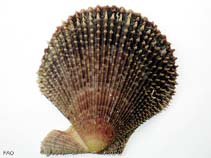Mimachlamys varia (Linnaeus, 1758)
Variegated scallop| Native range | All suitable habitat | Point map | Year 2050 |

|
| This map was computer-generated and has not yet been reviewed. |
| Mimachlamys varia AquaMaps Data sources: GBIF OBIS |
Classification / Names Tên thường gặp | Các synonym ( Các tên trùng) | CoL | ITIS | WoRMS
Bivalvia | Pectinida | Pectinidae
Environment: milieu / climate zone / Mức độ sâu / distribution range Sinh thái học
; Mức độ sâu 0 - 200 m (Tài liệu tham khảo 2754). Subtropical, preferred 16°C (Tài liệu tham khảo 107945); 69°N - 15°N, 25°W - 36°E (Tài liệu tham khảo 78075)
Distribution Các nước | Các khu vực của FAO | Các hệ sinh thái | Những lần xuất hiện | Những chỉ dẫn
Eastern Atlantic, Mediterranean and Black Sea: Norway to Senegal and Turkey.
Length at first maturity / Bộ gần gũi / Weight / Age
Chín muồi sinh dục: Lm ? range ? - ? cm Max length : 10.0 cm SHL con đực/không giới tính; (Tài liệu tham khảo 109255); Tuổi cực đại được báo cáo: 7 các năm (Tài liệu tham khảo 8702)
Life cycle and mating behavior Chín muồi sinh dục | Sự tái sinh sản | Đẻ trứng | Eggs | Sự sinh sản | Larvae
Main reference
Các tài liệu tham khảo | Người điều phối | Người cộng tác
Demir, M. 2003 Shells of mollusca collected from the seas of Turkey. Turkey Journal of Zoology 27:101-140. (Tài liệu tham khảo 2754)
IUCN Red List Status
(Tài liệu tham khảo 130435: Version 2025-1)
CITES status (Tài liệu tham khảo 108899)
CMS (Tài liệu tham khảo 116361)
Threat to humans
Human uses
Các nghề cá: Tính thương mại
| FishSource | Biển chung quanh ta
Các công cụ
Thêm thông tin
Max. ages / sizes
Length-weight rel.
Length-length rel.
Length-frequencies
Mass conversion
Sự phong phú
Các nguồn internet
BHL | BOLD Systems | CISTI | DiscoverLife | FAO(Publication : search) | Fishipedia | GenBank (genome, nucleotide) | GloBI | Gomexsi | Google Books | Google Scholar | Google | PubMed | Cây Đời sống | Wikipedia (Go, tìm) | Tạp chí Zoological Record



